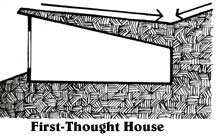China's Synthetic Natural Gas Plants Could Accelerate Climate Change - Businessweek
Unfortunately, one scheme to limit coal burning by converting China’s
plentiful coal supplies into synthetic natural gas (SNG) presents a
host of other ecological worries. To date, China’s government has
approved construction of nine large SNG plants in northern and western
China, which are projected to generate 37 billion cubic meters of gas
each year when completed. At least 30 more proposed plants are awaiting
approval.
None of these planned plants are located near large Chinese cities,
so the emissions generated in producing the gas will not hang directly
over metropolises. But that doesn’t mean the coal-to-gas conversion
process is clean. According to a new study (PDF) in Nature Climate Change,
the entire life cycle of harvesting coal and turning it into gas
produces from 36 percent to 82 percent more total greenhouse gas
emissions than burning coal directly—depending on whether the gas is
used to generate electricity or power vehicles.
While the most-polluting stages of energy generation could be moved
farther from China’s population centers—perhaps allowing for more
brighter, cleaner days in Beijing—the net effect could be to accelerate
global climate change, argue the study’s authors, Chi-Jen Yang and
Robert Jackson of the Nicholas School of the Environment at Duke
University.
Moreover, the scarcely populated hinterland regions earmarked for the
SNG plants are dry, while converting coal to gas is a water-intensive
process. “The water consumption for [synthetic natural gas] production
could worsen water shortages in areas already under significant water
stress,” write Yang and Jackson. “Overall, the large-scale deployment of
SNG will dramatically increase water use, [greenhouse gas] emissions,
and additional air and water pollution.”
When it comes to tackling China’s many environmental challenges,
it’s, alas, much easier to point out flaws in current government
approaches than to find sustainable solutions.
Solar Energy in Jordan

The
solar energy potential in Jordan is enormous as it lies within the
solar belt of the world with average solar radiation ranging between 5
and 7 KWh/m2,
which implies a potential of at least 1000GWh per year annually. Solar
energy, like other forms of renewable energy, remains underutilized in
Jordan. Decentralized photovoltaic units in rural and remote villages
are currently used for lighting, water pumping and other social services
(1000KW of peak capacity). In addition, about 15% of all households
are equipped with solar water heating systems.
Jordan
has major plans for increasing the use of solar energy. As per the
Energy Master Plan, 30 percent of all households are expected to be
equipped with solar water heating system by the year 2020. The
Government is hoping to construct the first Concentrated Solar Power
(CSP) demonstration project in the short to medium term and is
considering Aqaba and the south-eastern region for this purpose. It is
also planning to have solar desalination plant. According to the
national strategy the planned installed capacity will amount to 300MW –
600MW (CSP, PV and hybrid power plants) by 2020.
One
of the most promising potential investments in renewable energy
worldwide will be installing more than 250 MW of concentrated solar
power (CSP) in Jordan’s Ma’an development zone through different
projects developed by the private sector. The upcoming CSP solar power
plants in Ma'an would highlight Jordan's strategy of sustainable energy
diversification. The Ma'an Development Area enjoys about 320 days of
sunshine a year, with a high level of irradiance that allows over 2500
million kWh of primary energy to be harvested annually from each square
kilometre. At full capacity, the planned flagship CSP plant could meet
some 4% of the Kingdom's electricity needs, reducing the reliance on
electricity imports from neighbouring countries. Surplus energy could in
turn be sold to Syria, Egypt and Palestine, whose networks are
connected to Jordan.
Qawar
Energy in partnership with Maan Development Area (MDA) has recently
announced the launch of its $400 million Shams Ma’an Project, a 100MW
photovoltaic (PV) power plant project to come up at the MDA industrial
park in Jordan. The project, being undertaken in partnership with MDA,
is spread across a two million m2 area, and expected to
be ready in 2012. On completion, it will be the largest PV plant in the
world that will position Jordan on the global renewable energy map
attracting investments, technologies and knowhow. It aims to utilize
approximately 360,000 to 2 million PV/CPV panels and produce around 168
GWh per year
California-based
company Ausra has been chosen to supply solar steam boilers to the
100MW JOAN1 concentrated solar thermal power (CSP) project in
development in Ma’an. The JOAN1 project is expected to enter operation
in 2013 and will be the largest CSP project in the world using direct
solar steam generation. JOAN1 will be based on Ausra’s reflector
technology to power the plant’s solar steam cycle and generate up to 100
MW of electricity. JOAN1 will use dry cooling to conserve water. Ausra
plans to install an advanced manufacturing facility in Jordan in order
to supply JOAN1 with its solar steam boilers.







